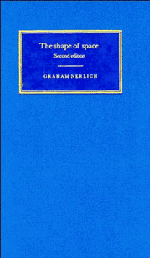Book contents
- Frontmatter
- Contents
- Preface
- Introduction
- 1 Space and spatial relations
- 2 Hands, knees and absolute space
- 3 Euclidean and other shapes
- 4 Geometrical structures in space and spacetime
- 5 Shapes and the imagination
- 6 The aims of conventionalism
- 7 Against conventionalism
- 8 Reichenbach's treatment of topology
- 9 Measuring space: fact or convention?
- 10 The relativity of motion
- Bibliography
- Index
8 - Reichenbach's treatment of topology
Published online by Cambridge University Press: 04 December 2009
- Frontmatter
- Contents
- Preface
- Introduction
- 1 Space and spatial relations
- 2 Hands, knees and absolute space
- 3 Euclidean and other shapes
- 4 Geometrical structures in space and spacetime
- 5 Shapes and the imagination
- 6 The aims of conventionalism
- 7 Against conventionalism
- 8 Reichenbach's treatment of topology
- 9 Measuring space: fact or convention?
- 10 The relativity of motion
- Bibliography
- Index
Summary
The geometry of mapping S2 onto the plane
Let us see, in this chapter, just what Reichenbach does with these conventional methods. Clearly, the strategy scrutinised in chapter 6 will lead us to discuss cases in more or less detail. But some cases are trivial, and we ought to set them aside. Here is a trivial case: there is only one material thing in the universe, a wooden ball. Topologically, it is a contractible three-space with a simply connected surface. Obviously there can be a ball with this local topology in E3, S3 or the toral threespace. It is easy enough to run up a large number of such trivial cases, but it is not very instructive to do so. What Reichenbach needs to claim is not that it is merely sometimes possible, but possible in every case, or possible in characteristically challenging cases, to redescribe the space's global topology. We want to see how the trick can be worked in those cases where the array and the movement of objects strongly suggests some non-Euclidean global topology. In particular, it is not obvious how the apparent enclosure relations of the cases already looked at can be redescribed. A principle which Reichenbach should and does allow is that objects can move anywhere in the space and, given a global topology (conventional or not) be related to each other topologically in whatever way is consistent with that space's topology.
Let's remind ourselves how to play this game. The positivist view is that privileged statements are about spacetime coincidences. This stems from Einstein's opinion that only differential structure is real, since physical theories must be generally covariant.
- Type
- Chapter
- Information
- The Shape of Space , pp. 180 - 194Publisher: Cambridge University PressPrint publication year: 1994



